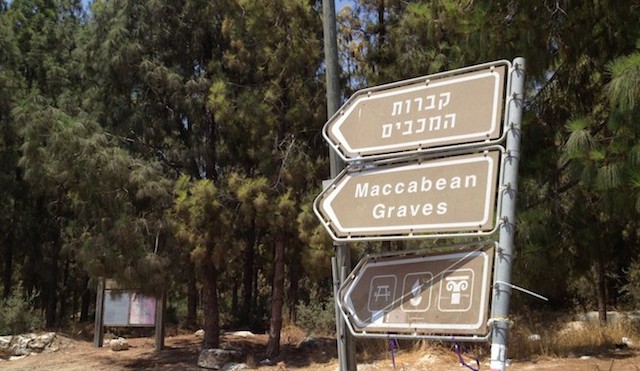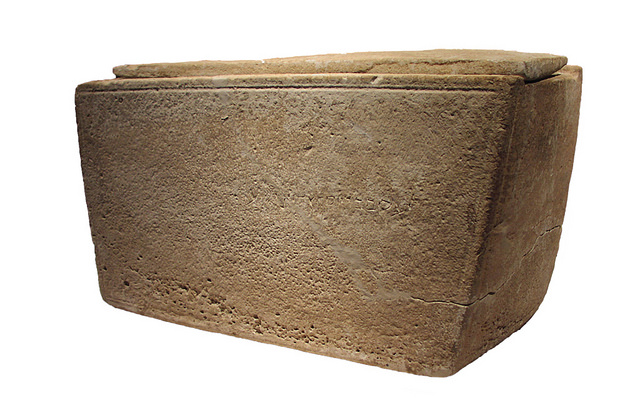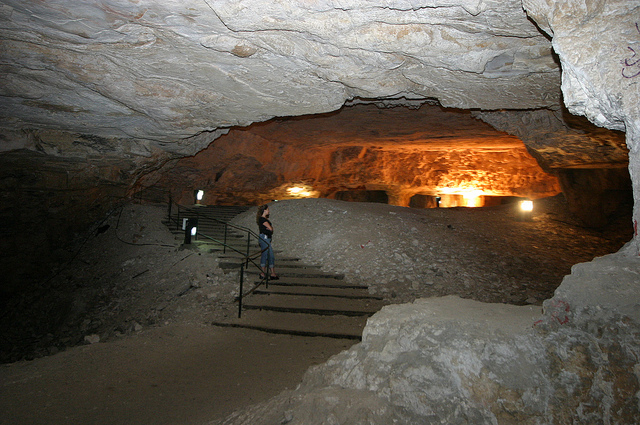10 Great Mysteries in Israel
June 20, 2014

Photo of Galgal Refaim courtesy of Wikimedia Commons.
If you’ve ever seen Raiders of the Lost Ark, you know that the history of the Holy Land is filled with intriguing mysteries. Despite Indiana Jones-style explorers’ best guesses, we don’t know where the ark and other precious furnishings from the first Holy Temple lie buried. And we’re still not certain who wrote each of the Dead Sea Scrolls.
Here is a list of other perplexing mysteries in Israel, some from thousands of years ago and others as recent as yesterday’s news.
1. Galgal Refaim
The mysterious ancients responsible for Britain’s Stonehenge could not have built Galgal Refaim (“wheel of ghosts”) or Rujm al-Hiri in Arabic (“stone heap of the wild cats”) between roads 808 and 98 in Israel’s Golan Heights. But like the much younger Stonehenge, Galgal Refaim (also called Gilgal Refaim) is remarkable for its stone structure achieved perhaps 6,000 years ago. An estimated 42,000 tons of basalt stone are laid out in four huge concentric circles that may have reached as high as 30 feet. The prevailing theory is that it was some sort of burial complex or cultic center – or both.
2. Kinneret mystery mound
 This drawing shows how the mound sits in the Sea of Galilee.
This drawing shows how the mound sits in the Sea of Galilee.
A stone’s throw from the baptismal site of Jesus on the Jordan River, Israeli researchers uncovered a third-century BCE conical mound of stones in the Sea of Galilee (Lake Kinneret to Israelis). Today it’s a convenient rest stop for summer birds, but some Christian speculators think it could have provided the platform for Jesus’ miracle of walking on water and rescuing followers. Prof. Shmulik Marco from Tel Aviv University believes the stones were a cairn to protect human remains, most likely constructed on land and pushed out to sea by an earthquake.
3. Lost tombs of the Maccabees
 This tourist spot isn’t the real deal. Photo by Matti Friedman/Times of Israel
This tourist spot isn’t the real deal. Photo by Matti Friedman/Times of Israel
Ancient sources reveal that the tombs of the Hasmonean heroes of the second-century BCE Hanukkah story – Mattityahu the priest, his wife and his five sons, known as the Maccabees – were marked by a magnificent pyramid structure visible from miles away. Yet adventurers and scholars have been searching unsuccessfully for this monument in the Modi’in area since 1866. A modern tourist site dubbed the Maccabean Graves actually dates from centuries after the time of the Maccabees. Antiquities Authority Archaeologist Amit Reem is trying to raise enough money to re-explore a site first suggested as the Maccabean tomb by a French scholar in 1896.
4. The helmet of the ancient warrior
 Photo of ancient helmet courtesy of Israel Antiquities Authority.
Photo of ancient helmet courtesy of Israel Antiquities Authority.
A 2,600-year-old bronze helmet covered with gold leaf and decorated with snakes, lions and a peacock’s tail was discovered during a dredging operation in 2007 in the waters of Haifa Bay. The Marine Archaeology Unit of Israel Antiquities Authority says it is one of the most ornate pieces of early Greek armor ever found, and surmises that it was worn by a wealthy Greek mercenary working for the Egyptian pharaoh Necho II. The helmet is now on display at the National Maritime Museum in Haifa, but how it got into the water in the first place is a mystery buried with its owner.
5. Atlit-Yam
Was this Israeli version of Atlantis washed away in Noah’s flood? Overtaken by a prehistoric tsunami or glacial meltdown? Nobody is sure how the Late Neolithic-era Atlit-Yam village, located some 400 meters off the shore between Atlit and Haifa, got submerged. But when it was discovered in 1984 during an underwater archeological survey, it was hailed as the largest and best-preserved prehistoric settlement ever uncovered off the Mediterranean coast. The approximately 8,000-year-old village contains buildings, human graves, wheat seeds and animal bones.
6. The Kiryat Yam mermaid
NBC and Animal Planet are among the international media outlets that have produced segments about the alleged mermaid spotted in the waters off Kiryat Yam, a blue-collar Israeli town near Haifa. The mayor even offered a $1 million reward to anyone who could prove the mermaid – or whatever is lurking in the water — really exists. Though the US National Oceanic and Atmospheric Administration responded to speculation about the Israeli mermaid several years ago by stating, “No evidence of aquatic humanoids has ever been found.” Locals aren’t convinced.
7. The James Ossuary
 Photo of the James Ossuary by Zev Radovan.
Photo of the James Ossuary by Zev Radovan.
Is a limestone casket from the early Common Era the resting place of Jesus’ brother? That was the subject of a long legal battle in Israel. The bone box, or ossuary, bought 25 years ago by an Israeli collector from an Arab antiquities dealer bears the inscription “James, son of Joseph, brother of Jesus.” The Israel Antiquities Authority charged that the “brother of Jesus” part was forged by the collector, but he was acquitted by a Jerusalem court in 2012 and got to keep his treasure. Though the debate continues unabated in scholarly circles, the ossuary is sure to be a hit with tourists if it ever goes on public display.
8. King Solomon’s Mines
 Archeologist Erez Ben Yosef directs digs at the Timna site.
Archeologist Erez Ben Yosef directs digs at the Timna site.
Did the wise Israelite King Solomon really have anything to do with the copper mines at Timna, near Eilat? The site traditionally called by his name was long thought to post-date him, and only last year was it determined – by carbon-dating ancient date and olive pits dug up there – that the mines were indeed in active use during Solomon’s 10th century BCE reign. Nevertheless, some historians think the mines were overseen by Egyptian or Edomite governments. Is some other, still-undiscovered site the real King Solomon’s Mines that are the stuff of legends and modern books?
9. Zedekiah’s Cave
 Photo of Zedekiah’s Cave courtesy of the Tourism Ministry.
Photo of Zedekiah’s Cave courtesy of the Tourism Ministry.
Speaking of Solomon, this quarry under the northern wall of Jerusalem’s Old City lay buried for more than 300 years until, in 1854, an American missionary’s dog dug through dirt near the Old City wall and disappeared through an opening. Legend has it that this was the cave through which biblical King Zedekiah unsuccessfully attempted to flee Jerusalem during a Babylonian siege in 422 BCE.
The cave’s other nickname is Solomon’s Quarry, and the Freemasons of Israel hold an annual secretive ceremony here as they consider King Solomon the original freemason. But it’s more probable that stones cut here were used for the fourth-century BCE Second Temple of Herod rather than Solomon’s ninth-century First Temple.
Adding to the cave’s mysterious allure, in 1968 an East Jerusalem man claimed his grandfather had buried three cases of gold in Zedekiah’s Cave and offered a quarter of the loot to the government if it would finance a dig. Nothing was found.
10. Oil in them thar hills?
As Israel’s discovery of huge natural gas reserves is poised to impact the country’s economy in future years, careful readers of the Bible are optimistic that they, too, will find vast oil fields hidden in the Holy Land – and some of them have hit potential pay dirt.
Evangelical Christian John Brown, founder of Zion Oil & Gas in Texas – and his 30,000 investors – believe that the book of Deuteronomy contains clues to oil fields in northern Israel, though four drilling expeditions thus far have come up dry. Meanwhile, Israeli oil company Givot Olam – whose hunches also are based on biblical passages — has indeed discovered onshore oil in commercial quantities, and is working with the government to develop these sites. In addition, Shemen Oil and Gas Resources last year discovered oil off the coast of Ashdod.
Similar posts
-

Israel Is Held To A Higher Standard Than Any Country
April 25, 2024In the intricate tapestry of global affairs, one nation stands out for enduring scrutiny and condem...
-

Israel Has The Most Moral Military In The World
April 10, 2024In the heart of a region often riddled with conflict, Israel stands out not only for its technologi...
-

The Resilience of the Israeli People
April 2, 2024Visitors from around the world have seen Hamas's October 7th Massacre's destruction in southern Isr...
-

Israel: Small Size, Big Impact
March 21, 2024Nestled along the eastern edge of the Mediterranean Sea, Israel is a land of immense historical sig...
-

Israelis Are Fighting For Their Lives
February 21, 2024By Jonathan S. Tobin The world looks a lot different from Kibbutz Kfar Aza than it does in the U...
-

Over 2 Million Arabs Live In Israel
January 23, 2024In the complex landscape of the Middle East, where diverse cultures and identities intersect, Israe...
-

'Fauda' Star Idan Amedi Injured Fighting in Gaza
January 8, 2024Despite the severity of his injuries, Amedi's father assured Israeli news channels that his life is...
-

Israel Is A Great Country To Live In
December 28, 2023Nestled at the crossroads of the Middle East, Israel stands as a vibrant and dynamic nation, offeri...




















Wow how cool! I cant wait to visit Israel!
Pretty cool stuff, although im betting that there are some other wonders yet to be discovered. I definitely looking forward to a nice trip to Israel.